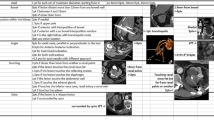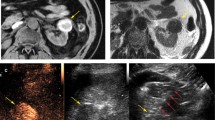Abstract
The aim of the study is to evaluate the performance of a simplified ABLATE score (sABLATE) in predicting complications and outcome with respect to RENAL, mRENAL, and ABLATE scores. This study included 136 renal lesions in 113 patients (M:F ratio = 2.5; mean age 70.8 years). 98 tumors underwent cryoablation at San Raffaele hospital between 01/2015 and 03/2020, while 37 underwent microwave ablation at San Paolo or Policlinico hospitals between 07/2016 and 03/2020. RENAL, mRENAL, ABLATE, and sABLATE scores were calculated using pre-procedural imaging. Data regarding complications and follow-up were registered. Mann–Whitney U test, ROC analyses, and logistic regression analyses were used for complications. Cox-regression analyses were performed for outcome. Mean tumor diameter was 23.2 mm. Mean and median RENAL, mRENAL, ABLATE, and sABLATE scores were 6.8 and 7, 6.9 and 7, 5.3, and 5, and 3.5 and 3, respectively. During a mean follow-up of 21.9 months (range 1–73), we registered 7 complications, 3 cases of residual disease, and 10 local tumor progressions. Mann–Whitney U test p values for complications for RENAL, mRENAL, ABLATE, and sABLATE were 0.51, 0.49, 0.66, and 0.056, respectively. ROC analyses for complications showed an AUC for RENAL, mRENAL, ABLATE, and sABLATE of 0.57, 0.57, 0.55, and 0.71, respectively. Regarding outcome, HR and p values of Cox-regression analyses were 1.30 and 0.36 for RENAL, 1.33 and 0.35 for mRENAL, 2.16 and 0.01 for ABLATE, 2.29 and 0.004 for sABLATE. sABLATE was the only score close to significance for complications, representing a progress even if not definitive. Regarding outcome, ABLATE confirmed its value, and sABLATE maintained validity despite being a simplification.



Similar content being viewed by others
Data availability
The datasets generated during and/or analyzed during the current study are available from the corresponding author on reasonable request.
References
Hollingsworth JM, Miller DC, Daignault S, Hollenbeck BK. Rising incidence of small renal masses: a need to reassess treatment effect. J Natl Cancer Inst. 2006;98(18):1331–4.
Znaor A, Lortet-Tieulent J, Laversanne M, Jemal A, Bray F. International variations and trends in renal cell carcinoma incidence and mortality. Eur Urol. 2015;67(3):519–30.
Shah PH, Alom MA, Leibovich BC, et al. The temporal association of robotic surgical diffusion with overtreatment of the small renal mass. J Urol. 2018;200(5):981–8.
Iannuccilli JD, Dupuy DE, Beland MD, Machan JT, Golijanin DJ, Mayo-Smith W. Effectiveness and safety of computed tomography-guided radiofrequency ablation of renal cancer: a 14-year single institution experience in 203 patients. Eur Radiol. 2016;26(6):1656–64.
Yang Y, Chen S, Chen F, et al. Outcome of radiofrequency ablation over partial nephrectomy for small renal mass. Int J Clin Exp Med. 2015;8(11):20670–4.
Trudeau V, Larcher A, Boehm K, et al. Comparison of postoperative complications and mortality between laparoscopic and percutaneous local tumor ablation for T1a renal cell carcinoma: a population-based study. Urology. 2016;89:63–8.
Larcher A, Trudeau V, Sun M, et al. Population-based assessment of cancer-specific mortality after local tumour ablation or observation for kidney cancer: a competing risks analysis. BJU Int. 2016;118(4):541–6.
Yu J, Zhang G, Liang P, et al. Midterm results of percutaneous microwave ablation under ultrasound guidance versus retroperitoneal laparoscopic radial nephrectomy for small renal cell carcinoma. Abdom Imaging. 2015;40(8):3248–56.
Pierorazio PM, Johnson MH, Patel HD, et al. Management of renal masses and localized renal cancer: systematic review and meta-analysis. J Urol. 2016;196(4):989–99.
Thompson RH, Atwell T, Schmit G, et al. Comparison of partial nephrectomy and percutaneous ablation for cT1 renal masses. Eur Urol. 2015;67(2):252–9.
Whitson JM, Harris CR, Meng MV. Population-based comparative effectiveness of nephron-sparing surgery vs ablation for small renal masses. BJU Int. 2012;110(10):1438–43.
Campbell S, Uzzo RG, Allaf ME, et al. Renal mass and localized renal cancer: AUA guideline. J Urol. 2017;198(3):520–9.
Finelli A, Ismaila N, Bro B, et al. Management of small renal masses: American society of clinical oncology clinical practice guideline. J Clin Oncol. 2017;35(6):668–80.
Motzer RJ, Jonasch E, Agarwal N, et al. Kidney cancer, version 2.2017: clinical practice guidelines in oncology. JNCCN J Natl Compr Cancer Netw. 2017;15(6):804–34.
Kutikov A, Uzzo RG. The R.E.N.A.L. nephrometry score: a comprehensive standardized system for quantitating renal tumor size, location and depth. J Urol. 2009;182(3):844–53.
Schmit GD, Thompson RH, Kurup AN, et al. Usefulness of R.E.N.A.L. nephrometry scoring system for predicting outcomes and complications of percutaneous ablation of 751 renal tumors. J Urol. 2013;189(1):30–5.
Camacho JC, Kokabi N, Xing M, et al. R.E.N.A.L. (radius, exophytic/endophytic, nearness to collecting system or sinus, anterior/posterior, and location relative to polar lines) nephrometry score predicts early tumor recurrence and complications after percutaneous ablative therapies for renal cell carcinoma: a 5-year experience. J Vasc Interv Radiol. 2015;26(5):686–93.
Sisul DM, Liss MA, Palazzi KL, et al. RENAL nephrometry score is associated with complications after renal cryoablation: a multicenter analysis. Urology. 2013;81(4):775–80.
Ierardi AM, Puliti A, Angileri SA, et al. Microwave ablation of malignant renal tumours: intermediate-term results and usefulness of RENAL and mRENAL scores for predicting outcomes and complications. Med Oncol. 2017;34(5):97.
Kim EH, Tanagho YS, Bhayani SB, Saad NE, Benway BM, Figenshau RS. Percutaneous cryoablation of renal masses: Washington University experience of treating 129 tumours. BJU Int. 2013;111(6):872–9.
Seideman CA, Gahan J, Weaver M, et al. Renal tumour nephrometry score does not correlate with the risk of radiofrequency ablation complications. BJU Int. 2013;112(8):1121–4.
Gahan JC, Richter MD, Seideman CA, et al. The performance of a modified RENAL nephrometry score in predicting renal mass radiofrequency ablation success. Urology. 2015;85(1):125–9.
Papa M, Suardi N, Losa A, et al. ABLATE: a score to predict complications and recurrence rate in percutaneous treatments of renal lesions. Med Oncol. 2020;37(4):26.
Rothman J, Crispen PL, Wong YN, Al-Saleem T, Fox E, Uzzo RG. Pathologic concordance of sporadic synchronous bilateral renal masses. Urology. 2008;72(1):138–42.
Dindo D, Demartines N, Clavien PA. Classification of surgical complications: a new proposal with evaluation in a cohort of 6336 patients and results of a survey. Ann Surg. 2004;240(2):205–13.
Ahmed M, Solbiati L, Brace CL, et al. Image-guided tumorablation: standardization ofterminology and reporting criteria-A 10-year update. J Vasc Interv Radiol. 2014;25(11):1691-1705.e4.
Zargar H, Atwell TD, Cadeddu JA, et al. Cryoablation for small renal masses: selection criteria, complications, and functional and oncologic results. Eur Urol. 2016;69(1):116–28.
Klapperich ME, Abel EJ, Ziemlewicz TJ, et al. Effect of tumor complexity and technique on efficacy and complications after percutaneous microwave ablation of stage T1a renal cell carcinoma: a single-center, retrospective study. Radiology. 2017;284(1):272–80.
De Cobelli F, Papa M, Panzeri M, et al. Percutaneous microwave ablation versus cryoablation in the treatment of T1a renal tumors. Cardiovasc Interv Radiol. 2020;43(1):76–83.
Maciolek KA, Abel EJ, Posielski NM, et al. Tumor location does not impact oncologic outcomes for percutaneous microwave ablation of clinical T1a renal cell carcinoma. Eur Radiol. 2019;29(11):6319–29.
Zhou W, Herwald SE, McCarthy C, Uppot RN, Arellano RS. Radiofrequency ablation, cryoablation, and microwave ablation for T1a renal cell carcinoma: a comparative evaluation of therapeutic and renal function outcomes. J Vasc Interv Radiol. 2019;30(7):1035–42.
Kim DK, Won JY, Park SY. Percutaneous cryoablation for renal cell carcinoma using ultrasound-guided targeting and computed tomography-guided ice-ball monitoring: radiation dose and short-term outcomes. Acta radiol. 2019;60(6):798–804.
Yamanaka T, Yamakado K, Yamada T, et al. CT-guided percutaneous cryoablation in renal cell carcinoma: factors affecting local tumor control. J Vasc Interv Radiol. 2015;26(8):1147–53.
Beksac AT, Rivera-Sanfeliz G, Dufour CA, et al. Impact of tumor histology and grade on treatment success of percutaneous renal cryoablation. World J Urol. 2017;35(4):633–40.
Haddad MM, Schmit GD, Kurup AN, et al. Percutaneous cryoablation of solitary, sporadic renal cell carcinoma: outcome analysis based on clear-cell versus papillary subtypes. J Vasc Interv Radiol. 2018;29(8):1122–6.
Acknowledgements
We thank Giacomo Mason, PhD, who provided statistical support and expertise for this research.
Funding
No funding was received for conducting this study.
Author information
Authors and Affiliations
Contributions
We declare that all authors have significantly contributed to all the steps of this research project, from ideation to final manuscript review. All authors have read and agreed to the submitted version of the manuscript.
Corresponding author
Ethics declarations
Conflict of interest
The authors have no conflict of interest to declare that are relevant to the content of this article.
Ethical approval
Ethical approval was given by IRBs/ Ethical approval was waived by IRB in view of the retrospective nature of the study and all the procedures performed were part of the routine care. The study was performed in accordance with the ethical standards as laid down in the 1964 Declaration of Helsinki and its later amendments or comparable ethical standards.
Consent to participate
Waived by IRB for this retrospective study, which is observational and didn’t modify the routine care in any way.
Consent for publication
Waived by IRB as no identifying information is present in the current study.
Additional information
Publisher's Note
Springer Nature remains neutral with regard to jurisdictional claims in published maps and institutional affiliations.
Rights and permissions
About this article
Cite this article
Papa, M., Biondetti, P., Colombo, R. et al. sABLATE: a simplified ABLATE score for prediction of complications and outcome in percutaneous thermal ablation of renal lesions. Med Oncol 38, 126 (2021). https://doi.org/10.1007/s12032-021-01542-6
Received:
Accepted:
Published:
DOI: https://doi.org/10.1007/s12032-021-01542-6




